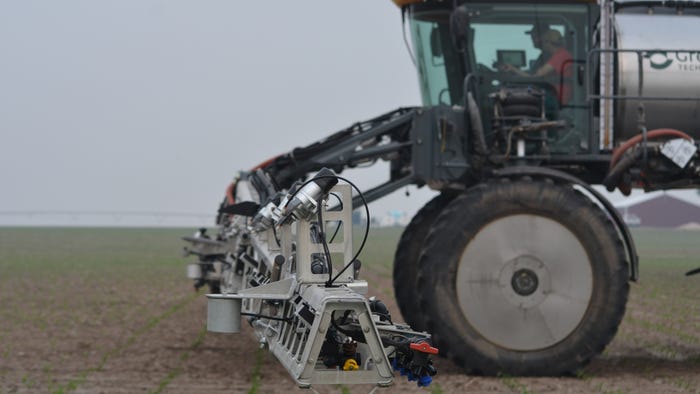
Photos by Curt Arens
In the old days, selective weed management meant hand-rogueing. In more recent years, it has meant more use of nonselective herbicides with herbicide-resistant crops. But what tools are next for managing weeds in row crops to keep those skyrocketing herbicide costs down?
For one new technology, the savings in the field is what catches your eye. What farmer wouldn’t want to save on herbicide costs and spray less, without giving up on weed pressure and yield? That’s exactly what new crop tech — such as Greeneye Technology, based in Tel Aviv, Israel, and tested over the past two years in crop fields in Nebraska and across the Midwest — promises to farmers.
Saving herbicide and money
Nebraska Extension weed management specialist Amit Jhala tested Greeneye’s proprietary AI-enabled precision spraying system against broadcast application of herbicides for corn last season, and the results were eye opening — a 94% reduction in burndown herbicide use during preemergence spraying compared to broadcast, with a cost savings of $24.70 per acre.
During postemergence spraying of nonresidual herbicide, there was an 87% reduction compared to broadcast application, with a cost savings of $40.50 per acre. Plus, the efficacy levels compared to broadcast were the same or similar on broadleaf weeds and slightly less than broadcast but still similar on grass weeds.
More testing this season
“This year, we are conducting a research project on a soybean grower’s field to evaluate how effective this precision sprayer will be in burndown application before planting soybeans, and then in a postemergence application,” Jhala says.
“This technology is exciting and will help growers to reduce herbicide use in burndown before planting crops and postemergence herbicide applications,” Jhala says. “Less use of herbicides is good for the environment, and it will save money for growers.”
How much is saved on herbicides depends on the amount of weed pressure in the field, but in general, this technology will help growers reduce the cost, compared to broadcast herbicide applications, he adds.
The technology was demonstrated at different locations across the Plains and Midwest in mid-May, including a demonstration at Marty Kinerk’s High Point Farm near Wilcox, Neb. At that field event, Farm Progress caught up with Nadav Bocher, the company CEO and co-founder, to talk about what makes Greeneye systems unique among some of the newer crop weed management technologies being employed.
Last year, the company worked with farmers in the Henderson and York, Neb., areas, using the company’s own sprayers to provide custom spraying. The focus this year is more commercialization in corn and soybean fields across Nebraska, Iowa, Illinois and into other ag states, but taking orders for units for the 2024 growing season.
While the system is commercial now for corn and soybeans, it is customizable for any crop. So, next season the company will add cotton and is working on adding canola and wheat.
About the system
In an overview of their system, Bocher said that Greeneye sensors are preinstalled on brand-new aluminum booms that replace the old booms on a retrofitted high-clearance machine. The boom demonstrated at Wilcox was 120 feet, fitted with 144 nozzles at about 10-inch spacing, along with 12 “black boxes” that include the computer and processors that make the system work.
“We have 24 cameras along the boom that are set slightly ahead of the boom, that can detect weeds for preemergent or postemergent, and within a millisecond, trigger individual nozzles to precisely spray just the weeds,” Bocher says. “We have 72 pulsing lights, so the system can work 24/7, early in the morning, late evening or in the pitch dark at night.” Each camera is fitted with an air line that blows dust from the camera to maintain accuracy through the field.
There are two lines of nozzles on the retrofitted booms from Greeneye. “We are converting the machine from a single line of nozzles and a single tank to a dual line of nozzles and a dual tank,” he says.
They don’t touch the original tank, but actually add a small tank to the machine. The original line of nozzles is in front of the boom for broadcast residual herbicides, and another line of nozzles in the back of the boom is part of the Greeneye system — individually controlled to precisely spray only the weeds running at speeds of up to 15 mph through the field. That’s a lot faster than those days of hand-rogueing in the fields.
Beating weeds
In addition to cost savings achievable through this system, Bocher highlighted another key benefit — improved weed efficacy. He explained that many of the farmers using the system are choosing to invest money they save in more powerful inputs that are simply not affordable when sprayed on a broadcast basis. This has the potential to significantly increase crop yields and provide farmers with a much-needed weapon in the growing fight against resistance, Bocher added.
Kinerk learned about the Greeneye system through Farmers Business Network, which is offering the technology in combination with its chemical programs to its farmer members for this year.
“Obviously, the chemical savings would be huge on any farm,” Kinerk says. He looks forward to more research on how well extremely small weeds are identified by the system, and if the system will require more passes across the field to get the same weed control throughout the growing season.
“There is a need to do more research in the future to see how the dual-tank system can help growers overcome herbicide antagonism that occurs when they tank-mix chemicals such as XtendiMax and Select Max in a single tank,” Jhala adds.
“This type of technology is just going to get better and better over time,” Kinerk notes. “This is obviously the future of weed management.”
Learn more at greeneye.ag or fbn.com.
About the Author(s)
You May Also Like






